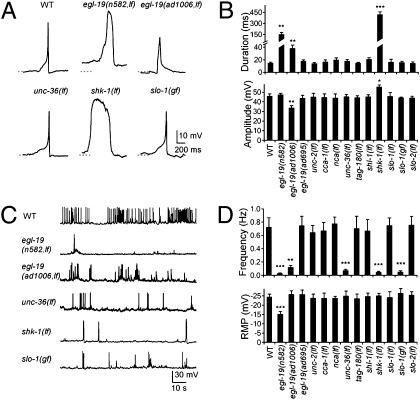Fig. 2.
Channels responsible for action potentials in C. elegans body wall muscles. (A) Representative single action potentials from WT and channel mutant muscles. Pronounced changes in kinetics were present in egl-19(n582,lf), egl-19(ad1006,lf), and shk-1(lf) but absent from unc-36(lf) and slo-1(gf) mutants. Dashed lines, −20 mV. (B) Quantification of the half-width and peak amplitude of action potentials in the respective channel mutants. An extension of duration was observed in egl-19(n582,lf), egl-19(ad1006,lf), and shk-1(lf). There was an increase of the peak amplitude in shk-1(lf) mutants but a decrease in egl-19(ad1006,lf) mutants. (C) Representative traces for trains of spontaneous action potentials in WT and mutant animals. (D Upper) The frequency of action potentials was decreased in egl-19(n582,lf), egl-19(ad1006,lf), unc-36(lf), shk-1(lf), and slo-1(gf) mutants. (Lower) The resting membrane potential was elevated in egl-19(n582,lf) mutants. *P < 0.05; **P < 0.01; ***P < 0.001; t test against WT. (Error bars = SEM.)

